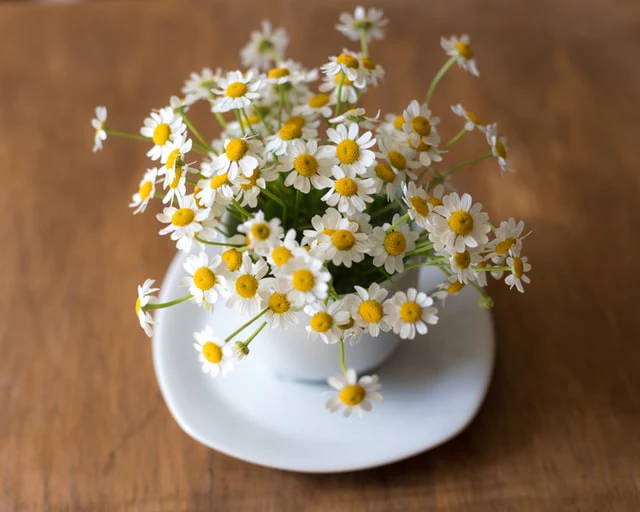Beyond Sleep Support: 5 Lesser-Known Medicinal Wonders of Chamomile
Beyond Sleep Support: 5 Lesser-Known Medicinal Wonders of Chamomile
Most of us are familiar with chamomile’s calming influence on sleep but most of us are unaware that this herb is a botanical treasure with a wealth of medicinal benefits that extend far beyond promoting a restful sleep. While its popularity as a sleep aid is well-established, there are many lesser-known facets to chamomile's therapeutic potential that are worth exploring. Below are five examples of some of chamomile’s remarkable benefits that go beyond lulling you to sleep.
1. Gastrointestinal Health1,2:
Chamomile has long been recognized for its ability to treat a wide variety of digestive issues. Its anti-inflammatory and antispasmodic properties make chamomile a gentle yet effective remedy for various gastrointestinal issues. From alleviating the symptoms of gastric ulcers and IBS, to easing indigestion, bloating, diarrhea, and gas, chamomile can be a natural tonic for your digestive system to support proper digestion. Consider sipping on some chamomile tea after meals to promote proper digestion.
2. Skin Health3:
Chamomile is known for its nurturing and soothing qualities for the skin. In fact, ancient Greeks, Romans and Egyptians used it to care for and promote wound healing. Packed with potent antioxidants and anti-inflammatory compounds, chamomile helps sooth and rejuvenate the skin. Topical applications of chamomile-infused creams or oils can soothe irritated and dry skin, reduce redness, and accelerate the healing process for minor wounds and skin conditions like eczema, and acne.
3. Allergy Defense4:
Chamomile's anti-inflammatory and antihistamine properties make it an effective remedy for allergy sufferers. Inhaling chamomile vapor or using chamomile tea as a nasal rinse can help provide relief from allergy symptoms like sneezing, itching, red eyes, and congestion. It’s soothing capacity also helps to minimize stress which can make allergy symptoms worse. Consider incorporating chamomile into your wellness routine during allergy seasons for a natural, soothing remedy. However, if you suffer from a ragweed pollen allergy, it is best to avoid chamomile as it has similar proteins to those found in ragweed that may cause allergic reactions.
4. Muscle Relaxant5:
The antispasmodic nature of chamomile makes it beneficial at relieving muscle tension and spasms throughout the body. Whether you're dealing with menstrual cramps or sore and achy muscles after a long day of work, chamomile's ability to relax smooth muscles can help offer natural relief to the tension. Enjoying a cup of chamomile tea, rubbing on some chamomile oil, or incorporating chamomile supplements into your healthcare routine may be a simple way to effectively reduce muscle tension.
5. Anticancer Potential6:
Research suggests that chamomile may have anticancer properties, thanks to its potent anti-inflammatory, and antioxidant effects and the heavy presence apigenin, a powerful plant flavonoid or pigment with known anti-cancer and chemoprotective effects. One study shows how the exposure of cancer cells to chamomile extracts significantly decreases their viability and induces cell death.
Chamomile, often praised for its sleep-inducing qualities, is an herbal marvel with a diverse array of medicinal benefits. From digestive support and skin healing to allergy relief and potential anticancer properties, chamomile proves to be an effective and versatile gift from nature worth incorporating into your regular care routine.
If you’re looking for sleep support and an easy way to incorporate chamomile into your regimen, consider Dr. Zelenko’s specially formulated sleep formula Z-Night, best taken before bed to help promote a restful night’s sleep.
References:
1. Alesaeidi, S., & Miraj, S. (2016, September 20). A systematic review study of therapeutic effects of Matricaria recuitta chamomile (chamomile). Electronic Physician, 8(9): 3023-3031. Retrieved from: https://doi.org/10.19082%2F3024
2. German chamomile. (n.d.). Mount Sinai. Retrieved from: https://www.mountsinai.org/health-library/herb/german-chamomile
3. Brinckmann, J., & Engels, G. (2015). Chamomile Matricaria chamomilla (syn. M. recutita, Chamomilla recutita) Family: Asteraceae. American Botanical Council, 108. Retrieved from: https://www.herbalgram.org/resources/herbalgram/issues/108/table-of-contents/hg108-herbpro-chamomile/
4. Aggarwal, G., & et al. (2022, October 19). A Comprehensive Study of Therapeutic Applications of Chamomile. Pharmaceuticals, 15(10): 1284. Retrieved from: https://www.mdpi.com/1424-8247/15/10/1284
5. Bartho, L., & et al. (2018, April 6). Evidence Supports Tradition: The in Vitro Effects of Roman Chamomile on Smooth Muscles. Frontiers in Pharmacology, 9. Retrieved from: https://doi.org/10.3389%2Ffphar.2018.00323
6. Gupta, S., & Srivastava, J. K. (2007, November 14). Antiproliferative and apoptotic effects of chamomile extract in various human cancer cells. Journal of Agriculture and Food Chemistry, 55(23): 9470-8. Retrieved from: https://doi.org/10.1021/jf071953k


Leave a comment